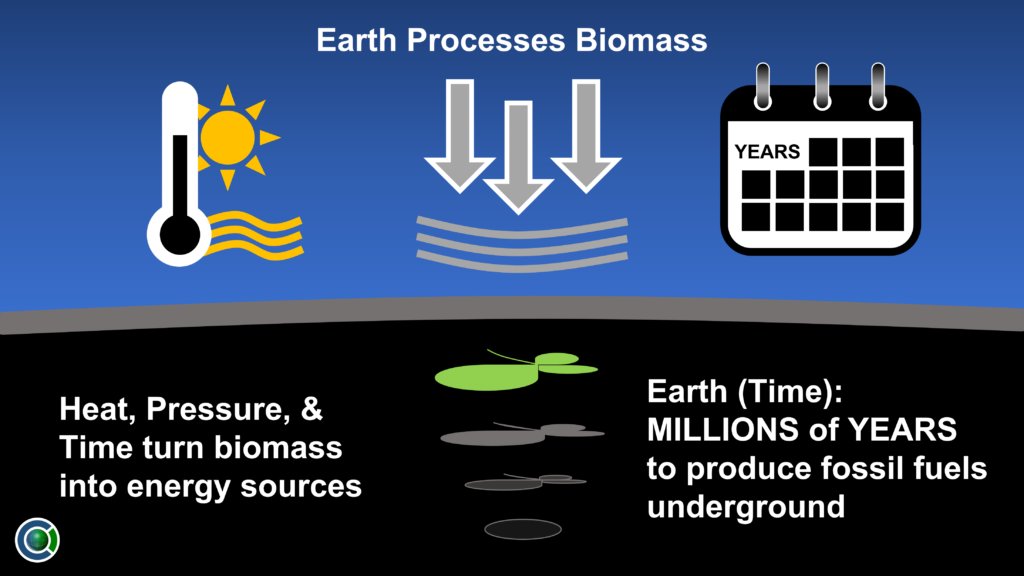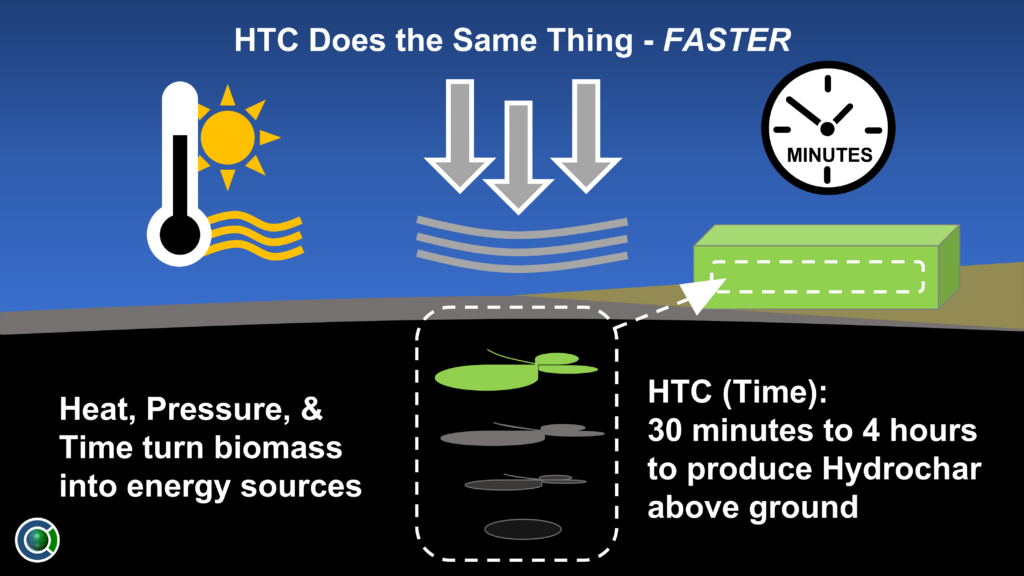Hydrothermal Carbonization (HTC) has a “reactor” at its core, which dramatically accelerates what the earth has done to produce fossil fuels from organic matter.
- HTC Reactor Size: 40’ Shipping Container (L 40’, W 8’, H 8’-6”)
- Processing Temperature: 360 to 430oF
- Processing Pressure: 290 to 360 psi
- Processing Time: 30 minutes to 4 hours
- CO2e Capture Efficiency: 90 to 95%



_____________________________________________________________________________________
HTC PERFORMANCE YIELDS
Food Waste to Hydrochar
Hydrothermal Carbonization can turn a liability (Food Waste) into an asset (Construction Sand). Each ton of food waste can yield .3 tons of Hydrochar (30%). Each ton of human sewage waste or animal manure yields .2 tons of Hydrochar (20%). This analysis uses a 25% yield on conversion of food waste given unknow factors around the mix of the type of food in any given market. For example, vegetables like lettuce that have high water content relative to more carbon rich bagels. Single HTC reactors can process 15,000 tons of sewage sludge into 3,000 tons of Hydrochar. A major processing plant with a set of six HTC reactors can process 100,000 tons of food waste into 30,000 tons of Hydrochar. The breakdown per HTC reactor is 16,666 tons of Food Waste into 5,000 tons of Hydrochar. This analysis uses a conservative 16,000 tons of Food Waste to 4,000 tons of Hydrochar to take into account discrepancies in the type of Food Waste supplied in any given market.
_____________________________________________________________________________________
HTC COSTS
Cost – Electricity Consumption
The electricity cost used in this analysis is $0.06/kWh. Across the U.S. the cost for industrial facility electricity ranges from the least expensive $0.52/kWh in Texas to the most expensive outliers like Hawaii with $0.27/kWh. The national average is $0.075, but that does not take into account off peak use of energy which brings down the cost. In almost all cases the HTC Reactors can run at night during off peak hours to take advantage of the lower cost of electricity.
Each HTC system is set up as a “train” to process the Food Waste. The HTC rector needs 300MWh of electricity and 3,100MWh of Thermal demand for Hydrochar dewatered to 55% dry. A MW is a MegaWatt equal to 1 million watts and 1,000 kilowatts (kW).
3,400MWh x 1,000 = 3,400,000kWh to run an HTC reactor x industrial average of $0.06/kWh = $204,000 to convert 16,666 tons of Food Waste into 5,000 tons of Hydrochar. $204,000 / 5,000 tons of Hydrochar = $40.8 per ton of Hydrochar.
We need to add in the electricity cost to covert the Hydrochar into sand. The energy consumption is 15.14kWh to tumble each ton of Hydrochar into sand.
Calculations: Tumblers use 50-60 kJ/kg. A joule (J) is the work required to produce one watt of power for one second, or one watt-second (W⋅s). 1 k is equal to 1,000 J.
To convert a kilojoule measurement to a kilowatt-hour measurement, you divide the energy by the conversion ratio. The energy in kilowatt-hours is equal to the kilojoules divided by 3,600 and 1 kJ = 0.000278 kWh) So, 60kJ = 0.01668kWh per kilogram of sand produced from hydrochar.
1 lb = 0.454 kilogram. So, 1 ton (2,000 lbs) = 908kg
The electricity to tumble a ton of hydrochar into a ton of sand (908kg x 0.01668kWh)
= 15.14kWh per ton of sand.
5,000 tons of sand (5,000 x 15.14kWh) = 75,700kWh x industrial average of $0.06/kWh = $4,542 to convert the Hydrochar into sand. $4,542 /5,000 tons = $0.91 per ton of sand.
Total energy cost to convert 16,666 tons of Food Waste into sand ($204,000 + $4,542) = $208,542.
This results in an energy cost per ton of sand ($208,542 / 5,000) = $41.20
Total energy consumption per HTC Reactor with Tumblers (3,400,000kWh + 75,700kWh) = 3,475,700kWh. To get to the energy cost per ton of sand: 3,475,700kWh / 5,000 tons = 695.14kWh. At the same industrial average of $0.06/kWh this is a cross check on the calculations above and it matches to within about 10% for an energy cost of $41.70 per ton of sand. For this analysis, we will round it up to $42 of energy per ton of sand. Naturally this number varies slightly by location and utility company. The industrial average of industrial electricity in the U.S. is about $0.06 and in a state like Pennsylvania it is higher at about $0.07/kWh with some volume buyers paying below $0.05/kWh in Pennsylvania and other states.
Cost – Human Capital
To achieve this, the energy cost of $42 per ton is increased with the human capital cost to manage the reactor. A “super center” facility with 6 HTC reactors and tumblers processing 100,000 tons of Food Waste into 30,000 tons of Hyrochar and the resulting 30,000 tons of sand, has an annual human capital cost of under $150,000, with three to five people operating the plant:
1 office staff (invoicing, AP, bookkeeping, etc.)
1 mechanic
1 laborer
Note that most of the process is automated so labor costs are minimal. Depending on input size, this human labor cost could increase at super centers by 2x or 3x up to $450,000. For a single HTC reactor plant, this analysis uses $120,000 annual human capital cost, given that a mechanic and administrator can service multiple single HTC reactor facilities if they are located within a metro market and within an hour drive of each other. Using the $120,000 per HTC Reactor, $120,000 / 4,000 tons of sand = $30 per ton of sand. $60 of electricity + $30 of labor = $90 of cost per ton of sand.
Total energy cost to convert 16,666 tons of Food Waste into sand is 3,475,700kWh which averages to $208,542 + Human Capital Cost of $120,000 = $328,542
Cost – Upfront Equipment
To further explore the business model, the key question is as follows: How much does it cost upfront to build one of these hydrothermal carbonization facilities to convert food waste into construction sand?
The short answer is less than you would think.
Equipment Cost:
Hydrothermal Carbonization Reactor (size of 40’ Shipping Container): $5,000,000
Tumbler: $250,000
Support Equipment, and Administrative Structure: $250,000
Total: $5,500,000
Cost – Real Estate Footprint
The land requirement for a plant that has six (6) HTC “trains” is about 12 to 14 acres. While the actual HTC Reactor is the size of a 40’ shipping container (L 40’, W 8’, H 8’-6”) the added area is for the logics of trucks to drop off the biowaste and area for support equipment such as tumblers. For a single HTC Reactor the expected area requirement is about 2 acres.
Option #1: Co-location at Landfills or Wastewater Treatment Plants (WWTP) that already have real estate.
Option #2: An adaptive reuse approach to convert any number of the shopping malls near U.S. metro markets into HTC Reactor processing plants for biowaste resource recovery. Coresight Research has predicted that 25% of America’s estimated 1,000 malls will close by 2025, which is often accelerated by the closure of one or two department stores at the site.
In surveying 10 U.S. markets, CBRE found the average price for “large industrial parcels” (50 to 100 acres) now sits at more than $100,000 per acre, up from about $50,000 a year ago. At $100,000 / acre for 2 acres, the $200,000 cost of land that could be financed, is less than 5% of the projected upfront cost. 10 year financing on $200,000 at 5.5% = $2,170.53/month. Annualized over 12 months this is an added $26,046 per year. The projected annual revenue analysis in a sperate section of this report, ranges rom $1 million to over $1.6 million per year, making the potential annual financing cost about 2.6% or less of the annual revenue.
Note: Given the co-location or adaptive reuse options, and the significant range of costs per acre for industrial land, this analysis does not factor in the cost of land.
